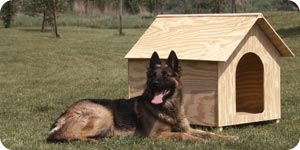
Building a dog house can provide your pet with shelter when outdoors. The house can provide shade in the summer, protection from rain or snow during inclement weather and simply a place for your dog to relax any time of year. Sure, you could buy outdoor dog houses, buy why not build your own? Here’s how to do it:
Before attempting to build an outdoor dog house, you should consider a number of factors including the following:
- Size of the dog.
- Purpose of the house.
- Spatial constraints.
- Location of the house.
- Climate of the location.
- Budget of the project.
All of these factors are important because they will help you to determine the size you will build, the materials you will use in construction and other considerations such as the placement once it is constructed. After you make all of these decisions, it’s time to begin your project.
Even if you have never completed a project of this nature, with some simple guidance and some woodworking knowledge, you can build a beautiful shelter for your canine companion. Don’t worry if you need to build a large or a small house–these instructions will work for all sizes. The following steps will guide you:
- Planning your project is the first step in the design process. You have already considered a number of factors that will help you determine the size, shape and materials. You can use this information to map out your project in terms of dimensions. When crate-training, it is recommended that you use a crate that is only large enough for the dog to stand up, turn around and lie down, but a dog house should be considerably larger than this because it is used for both shelter and recreation. Consider selecting a crate size appropriate for potty training and scaling those dimensions up slightly to allow more room to relax. The size should be large enough to accommodate your dog at his full size. If you have a puppy, it might be wise to either wait until he is fully grown or construct the house to accommodate the larger end of the breed spectrum.
- Once you have determined the dimensions, it is time to begin construction. In most cases, wood is an appropriate material to use, and for the purposes of this article we will assume the house will be constructed of wood.
- Floor structure: The floor structure can be made of 2×4 pieces of pressure-treated lumber. The pieces will be measured and cut to create a footprint of the desired size, and joists should be included as necessary. For larger houses this may include joists every 16 inches. Please note that pressure-treated lumber should not be used in locations where the dog may chew on the wood, as it contains chemicals that may be harmful. The framework for the floor can then be covered in plywood. Thicker plywood such as 1/2″ thick varieties may be necessary for larger dogs, but 3/8″ may be acceptable for smaller breeds.
- Sidewalls and back wall structure: The structure for the sidewalls and the back wall can be created of 2×2 pieces of lumber forming a square or rectangular shape. Again, studs can be placed every 16 inches along the structure if necessary.
- Front structure: The front structure typically includes the entrance. This is comprised of 2×2 lumber and can consist of a horizontal piece and two vertical elements to form the doorway. Alternately, this piece can be replaced by a sidewall structure and one of the sidewalls can serve as the entrance.
- Assembling the framework: Once the framework is completed, attach it to the floor system. Wood screws and nails can be used to connect each element to the floor and L-brackets along with screws and nails can be used to join the sections to each other.
- Roof joists: The roof joists can be assembled at a 30 degree angle to ensure rain will adequately run off the roof. These joists can be notched precisely so they will sit firmly on top of the wall structures.
- Siding: Plywood of 3/8″ thickness can be used for the walls and roof. The siding should be cut precisely to ensure there will not be gaps in the structure, and can be nailed directly to the framework.
- Roof: Plywood of 3/8″ thickness can also be used for the roof. As with the siding, the roof can be nailed directly to the roof joists. Although the wood is sufficient, shingles or other decorative elements can also be added if desired.
- Finishing: The appearance of a dog house is largely a matter of personal preference, but care should be taken to ensure all materials used in painting or treating the structure will not be toxic to your pet. If you have any question regarding the contents of a paint or treatment, contact an authority such as a poison control center that can help you determine whether or not the substance is safe.
